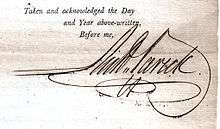Richard Varick
| Richard Varick | |
|---|---|
 | |
| 45th Mayor of New York City | |
|
In office 1789–1801 | |
| Preceded by | James Duane |
| Succeeded by | Edward Livingston |
| New York State Attorney General | |
|
In office May 14, 1788 – September 29, 1789 | |
| Preceded by | Egbert Benson |
| Succeeded by | Aaron Burr |
| Personal details | |
| Born |
March 15, 1753 Hackensack, Bergen County, Province of New Jersey |
| Died |
July 30, 1831 (aged 78) Jersey City, Hudson County, New Jersey |
| Nationality | American |
| Political party | Federalist |
Richard Varick was an American lawyer and politician. He was born on March 15, 1753 at Hackensack in Bergen County, New Jersey, and he died on July 30, 1831 at Jersey City in Hudson County, New Jersey.
Biography
American Revolutionary War
At the outset of the American Revolution, he was studying law at King's College (the former name of Columbia University) in New York City. He suspended his studies and became a captain in the militia. On June 28, 1775, he was appointed captain of the 1st New York Regiment. He served under General Philip Schuyler in various posts until after the Battle of Saratoga when he was appointed inspector-general of West Point.
At West Point, he became an aide to General Benedict Arnold. Although he was no longer serving in this capacity when Arnold defected to the British, Varick, along with David Franks, was arrested. The two were subsequently cleared by a court of inquiry. After the West Point incident, Varick served under General George Washington as private secretary until the end of the war.
After the war

Varick was Recorder of New York from 1784 to 1789, and New York State Attorney General from 1788 to 1789. He was Mayor of New York City from 1789 to 1801. While Mayor, he focused on the yellow fever epidemics which struck repeatedly. Along with Samuel Jones, Varick revised and standardized the statutes of New York (1788). He was a member of the New York State Assembly from New York County from 1786 to 1788, and he was Speaker during the sessions of 1787 and 1788. Meanwhile, he served as a colonel in the state militia.
Later life
Varick also served as a bank officer. He was a founder and later president (succeeding John Jay) of the American Bible Society, as well as a member of the Society of the Cincinnati and president of the New York chapter until his death. As such, he was responsible for maintaining the legacy of George Washington. From 1790 to 1836, celebrations of Washington's birthday in the City included Tammany Hall dinners, Washington Benevolent Society parades and an intimate open house held each February 22 by Mary Simpson (c. 1752-March 18, 1836), at her John Street grocery. Varick was a member of, and generous contributor to, many charitable organizations in New York City.
Having no children, he was survived by his wife Maria Roosevelt. He left his estate to his wife and relatives. Varick was interred at the First Reformed Dutch Church Cemetery in Hackensack, New Jersey.[1]
Legacy
The Town of Varick, New York, Varick Street in Jersey City and Varick Street (where he once owned property) in Manhattan in the City of New York bear his name.[2]
References
- ↑ Richard Varick, Find A Grave. Accessed August 7, 2006.
- ↑ Downtown Street Names and the Stories They Tell, LowerManhattan.info. Accessed August 22, 2007. "An extension of Seventh Avenue leading south from Clarkson Street, Varick Street got its name from Richard Varick, who served as the mayor of the city from 1791 to 1801."
- Photographs of gravesite
- Political Graveyard
External links
| Political offices | ||
|---|---|---|
| Preceded by John Lansing, Jr. |
Speaker of the New York State Assembly 1787–1788 |
Succeeded by John Lansing, Jr. |
| Preceded by James Duane |
Mayor of New York City 1789–1801 |
Succeeded by Edward Livingston |
| Legal offices | ||
| Preceded by John Watts |
Recorder of New York City 1784–1789 |
Succeeded by Samuel Jones |
| Preceded by Egbert Benson |
New York State Attorney General 1788–1789 |
Succeeded by Aaron Burr |
| ||||||
| ||||||||
| ||||||
|